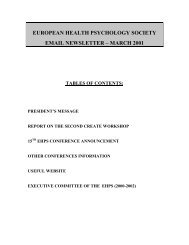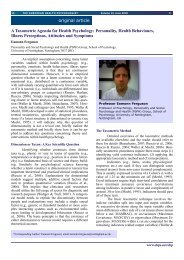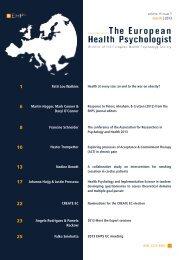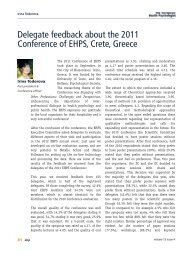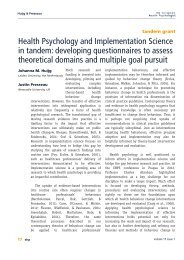PDF download entire issue - European Health Psychology Society
PDF download entire issue - European Health Psychology Society
PDF download entire issue - European Health Psychology Society
Create successful ePaper yourself
Turn your PDF publications into a flip-book with our unique Google optimized e-Paper software.
www.ehps.net/ehp<br />
fmri in health psychology<br />
A related problem is that, when effects in<br />
underpowered studies do attain statistical<br />
significance, they tend to be grossly inflated<br />
(Yarkoni, 2009). The reason is that, when power<br />
is very low, the only way to detect an effect is to<br />
capitalize on chance. For instance, in a sample of<br />
20 subjects tested at p < .001, the minimum<br />
statistically significant correlation is 0.67. A<br />
population correlation of, say, 0.3 will appear<br />
smaller or larger in any given sample due to<br />
sampling error; however, it will only be<br />
successfully detected in our small sample on<br />
those rare occasions when it is greatly inflated<br />
by chance. The problem is particularly acute in<br />
the context of the massive univariate analyses<br />
frequently performed in fMRI studies, because<br />
effects that may in truth be relatively weak and<br />
spatially diffuse will often appear to be spatially<br />
selective and extremely strong. For instance, if<br />
activity in half of the brain correlates 0.3 with<br />
some outcome variable in the population, we can<br />
expect the above sample to successfully detect<br />
the effect in fewer than 2% of voxels. And<br />
within the identified voxels, the observed<br />
correlation will be hugely inflated—averaging<br />
somewhere around 0.75 (Yarkoni, 2009).<br />
Paradoxically (and unfortunately), such biased<br />
findings may actually be easier to publish,<br />
because it’s often more exciting to conclude that<br />
one has identified a highly circumscribed brain<br />
region that accounts for half of the variance in<br />
some outcome than to conclude that fully half of<br />
the brain is associated—but only weakly—with<br />
that outcome.<br />
Not quite mind reading: the challenge of<br />
interpreting brain images<br />
A second set of challenges concerns the<br />
interpretation of fMRI results. As difficult as<br />
behavioral results can be to interpret,<br />
neuroimaging results add an additional layer of<br />
complexity. Perhaps the most common approach<br />
to interpretation of fMRI results takes the<br />
following form: we observed activation in region<br />
december | 2011<br />
R; given prior literature demonstrating that R is<br />
involved in process P, this suggests that<br />
differences in process P, mediated by region R,<br />
may explain differences in outcome variable V.<br />
This type of inference can be broken down into<br />
two strong claims: first, that there’s a causal<br />
relationship between the observed changes in<br />
activation and some observed behavioral<br />
difference; and second, that we can readily infer<br />
what cognitive process such changes in<br />
activation reflects. In practice, both of these<br />
claims turn out to be surprisingly difficult to<br />
establish.<br />
Consider the first claim. Suppose we observe,<br />
say, that the degree of right IFG activation in<br />
response to smoking cues predicts later success<br />
at abstaining from smoking. Can we conclude<br />
that IFG plays a causal role in mediating<br />
smoking abstinence? Not easily. Increased IFG<br />
activation in abstinent smokers could simply<br />
reflect the downstream effects of a critical<br />
upstream difference in a different process. For<br />
instance, smokers with greater motivation to<br />
quit might plausibly be more engaged with the<br />
task during scanning, and consequently expend<br />
more cognitive effort or spend more time<br />
attending to the on-screen stimuli. Because the<br />
blood-oxygen-level-dependent (BOLD) signal<br />
measured by fMRI sums approximately linearly<br />
over time, any increase in the amplitude or<br />
duration of neuronal processing will generally<br />
translate into a corresponding increase in the<br />
BOLD signal, irrespective of the efficacy of those<br />
processes in regulating behavior or other brain<br />
systems (Yarkoni, Barch, Gray, Conturo, & Braver,<br />
2009). In other words, a change in IFG<br />
activation tells us only that there was more<br />
processing in IFG neurons; it doesn’t tell us why.<br />
It certainly wouldn’t imply that any cognitive<br />
process supported by IFG is the rate-limiting<br />
factor in ability to quit smoking. We can view<br />
the problem counterfactually: if we could<br />
manipulate smokers’ brains to make them more<br />
ehp 62



